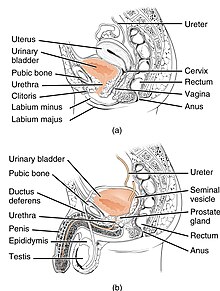Urethra
The urethra is a tube that connects the bladder to the outside of the body. All mammals have it. It allows the removal of urine from the body. There is a muscle (the urethral sphincter) which controls urination.

In male mammals, the urethra is also a part of the reproductive system, because males use it as a tube for sperm during sex.
Human anatomy change
In human anatomy, men have longer urethras than women. This means that women have bladder infections more often because their bladders are closer to the outside. Because the male urethra is longer and is not straight, inserting a catheter (tube to help urination) is more difficult in men.
In women, the urethra is 3-4 cm (1.5 in) long. It's opening to the outside of the body is part of the vulva (the area between a woman's legs). The female urethra is between the clitoris and the opening to the vagina. Men's urethra goes through their penis, but in women, it is not in the clitoris.
In men, the urethra is about 20 cm (8 in) long and its opening to the outside of the body is at the end of the penis. The male urethra has three sections:
- The prostatic urethra crosses the prostate gland. The vas deferens also opens into the urethra in this section.
- The membranous urethra is a short section that goes through the urethral sphincter. It is 1 or 2 cm long and is the narrowest (least wide) part of the urethra.
- The spongy or penile urethra goes through the penis on its lower side. This section is 15-16 cm (6 in) long and goes through the corpus spongiosum.
Medical problems change
- Urethritis is an infection of the urethra. It often causes pain when urinating.
- Kidney stones that go through the urethra can cause a lot of pain.
Medical procedures change
- To send a tube up the urethra to help drain urine is a common type of catheterization.
- To send a tube up the urethra to see the inside of the bladder is called cystoscopy.
| Urinary system (edit) | |
| Kidneys | Ureters | Urinary bladder | Urethral sphincters | Urethra |